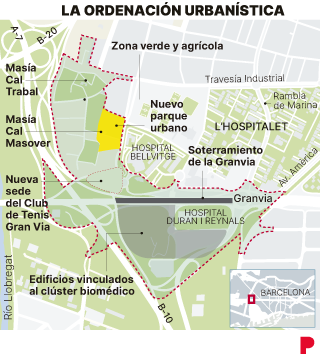On October 7, 2020, the Superior Court of Justice of Catalonia annulled the Granvia-Llobregat Urban Master Plan (PDU), a project that the L’Hospitalet City Council considered capital for the future of the second city of Catalonia, specifically for a major remodel of its south gate. Eleven months later, the Supreme Court also did not admit the appeal presented by the consistory itself, the Generalitat and the consortium involved. There were two legal setbacks in a row, but the municipal government of Núria Marín de give new impetus to his ambitious plan. In addition to relevant urban issues in an area that covered 105 hectares, it includes the creation of a biomedical research cluster. The presence of the Bellvitge Hospital, the Health Sciences campus of the University of Barcelona (UB), the Bellvitge Biomedical Research Institute (Idibell) and the Duran i Reynals Hospital, headquarters of the Catalan Institute of Oncology (ICO ), are strong arguments for a project that the courts threw back, Mainly, more for questions of form than substance. It was a competitive aspect. L’Hospitalet had sought the Conselleria de Territori as a travel companion and the courts understood that it should be the Metropolitan Area of Barcelona (AMB).
“What did we do after those sentences? Wait for the double appeal? It was the first option, although it was going to take time. The second meant doing nothing and trying to talk to the AMB, but they do not make master plans with a city council, but their own. And the third, the most practical, was to restart the process taking advantage of what we had. Fundamentally, we had to further justify the supra-municipal impact of the PDU, far beyond the local”, recalls Fran Belver, the first deputy mayor of L’Hospitalet de Llobregat. The decision was quick. In December 2020, a month after the Supreme Court ruling, they took the new plan to Territori with a different arrangement and with a reinforcement of the declaration of territorial interest. A study commissioned from the UB has put figures on the economic impact of the PDU Gran Via-Llobregat. At full capacity, says that report, it would mean a turnover of 6,800 million annually, 1.82% of the GDP of Catalonia. “The development of the planned roof justified the theory that the impact went beyond the city of L’Hospitalet itself”, says Belver. It is one of those so-called country projects, as they have always repeated from the consistory and that the Govern de Pere Aragonès itself subscribes to.

Collect the claims
The pattern of the new master plan differs from the previous one. The city council does not hide that it has wanted to collect the allegations presented prior to the judicial ruling. This is where Can Trabal came into play, the country house located in one of the sectors of the plan, and whose preservation was the banner of environmental impact brandished by opponents of the plan, whether from political groups or social entities. A sector close to the farmhouse has been eliminated, with the reduction of 70,000 meters of buildable land, and the qualification of a green area is maintained, admitting the agricultural use of the farmhouse as precarious, linked to the Parc Agrari del Baix Llobregat. “It has been classified as a green area since 1976 and agricultural use has been allowed & rdquor ;, recalls Belver. 85% of agricultural use will be maintained (basically artichokes are grown) and the remaining 15% of its 28 hectares will be used as a public park, next to the sports facilities that are currently in the Tenis Gran Via, and that will be relocated. “All the building area would be below the Gran Via, as requested in the lawsuits that were filed via litigation. We moved it away from the Bellvitge Hospital and from the houses in the neighborhood & rdquor ;, points out the first deputy mayor. This buildability is specified in 400,000 meters destined for economic and educational activities (university and post-university) as the great package, together with other parts destined for commercial and restoration, non-permanent residential (hotels) and student residences. In no case, emphasizes the city council, is it about housing construction.
Improve access to the Llobregat river park
Related news
The reactivation of the south gate of the city also contemplates the creation of two green areas on both sides of the Granvia to improve with footbridges, and an underpass, access to the Llobregat river park. Also the burying of part of that great entrance artery to Barcelona, through which 115,000 vehicles pass every day, of which 20,000 would remain on the surface. “We are going to an improved and sustainable mobility & rdquor ;, emphasizes Belver. The remodeling of the entire area, which will an investment of 202 million euros, It will also come from an international ideas competition to set the volumes and a global image for the works.
Today, the new project of the PDU Granvia-Llobregat is in the citizen participation phase posed by the urban planning law, which was not in force with the previous one. Polytechnic commission with political groups and entities, a participatory process in the Consell de Ciutat and in district 6 (Bellvitge) and debate tables (two this April) are the forums that must polish a year of negotiations and approval. The works would be tendered in 2023, in parallel to those of the other major project that L’Hospitalet is facing: the burying of the train tracks. And at the beginning of 2024, according to Fran Belver, work should begin to make what is now an area of diverse use (wasteland, TMB garages, Duran i Reynals car park, semi-landfill) an economic development hub for the second city of Catalonia.